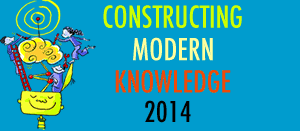Australia has long been a stronghold of digital game-making and programming as an academic subject. Why Australia? My friend Tony Forster says this, “I’m wary of stereotypes but we do have a national stereotype of making do with improvised junkyard creations, that fits with taking game freeware and repurposing it. We seem to lean more to constructivism than the US. The US leans particularly towards instruction in the current pendulum swing.”
From my own travels, I hear quite a bit of interest in U.S. schools about game design and robotics. It’s time for the pendulum to swing back! So, we can look to Australia for a peek into the community and resources that sustain this terrific educational activity. Warning! This is a long post!
“The computer is a medium of human expression and if it has not yet had its Shakespeares, its Michelangelos or its Einsteins, it will. …. We have scarcely begun to grasp its human and social implications.”
Computer Criticism vs. Technocentric Thinking By Seymour Papert
A Peek into the Australian GameMaker Community
GameMaker is one of a number of educationally-appropriate engines available for game development. Three Australians: Bill Kerr, Margaret Meijers and Tony Forster independently discovered Gamemaker and its potential as a learning tool for school students. Through their efforts, a number of Australian Schools have discovered Gamemaker and built a strong community that supports their own efforts and welcomes new participants.
Bill Kerr teaches secondary school students at Woodville High School, Margaret Meijers teaches at Newtown High School and has developed material for the Tasmanian Education Department, and Tony Forster, a parent, runs the Haileybury Computer Club.
Here are their websites:
- Schoolgamemaker - Programming Games at School Tony Forster’s website has sample student work, useful snippets of code, and a collection of quotes and articles supporting game design in school.
- Bill Kerr’s Website Articles and free GameMaker educational resources
- ICT Mindtools Extensive website by Margaret Meijers with links, tutorials, resources for teachers and video demos. “The title ‘ICT Mindtools’ is designed to bring a focus on uses of ICT where students are required to use higher order thinking skills to become producers, rather than just consumers, of ICT products.”
One of the many communities for Australian teachers about game design.
There are teachers all around the world using game design and programming as an educational activity, but I think the Australian community is particularly strong, and a great example of just a few like-minded people finding each other across space and time to build community and share resources.
Pedagogical base supporting game design as an educational activity (most of this supplied by Tony)
Game design and programming is firmly based in constructivist learning theory - that children learn best when they are active agents in their learning and are given authentic and relevant tasks.
Game programming was advanced by Seymour Papert of MIT and is the originator of Logo which later was commercialized as Microworlds. MIT was also involved in the programming of Lego Mindstorms. The justification for teaching Logo to young children was that programming a computer is a powerful experience where a child can “…learn to do things that no child could do before, to do things at a complexity that was not previously accessible to children.” (Papert)
Seymour Papert - Collected Works. Seymour Papert is the father of educational computing, and often talks about children making games as part of his vision that students use computers as constructive materials in every aspect of education. A good article to start with is Looking at Technology Through School-colored Spectacles.
There is research which supports the value of game programming as an educationally valuable activity for children of all ages.
- Computers Support Algebraic Thinking, Douglas H. Clements and Julie Sarama
- The Fifth Dimension Cognitive Evaluation, Final Report (Tony’s note: I think, a significant document. The study found “evidence across three different sites and using a collection of cognitive outcome measures that participation in the Fifth Dimension resulted in improvements in children’s literacy”. The study concentrated on literacy, not the normally expected mathematical and logical skills. Detailed testing methodology is given.)
- Virtual Manipulatives
- PDF - Game Design in Education Mark Overmars Institute of Information and Computing Sciences
- The Case for Computing - Gary Stager
- PDF - Learning and teaching in the contexts of creating computer games Dr Bernard Holkner Monash University
Books
- The Game Maker’s Apprentice: Game Development for Beginners
by Jacob Habgood & Mark Overmars (Amazon link) - Minds in Play: Computer Game Design as a Context for Children’s Learning (Lawrence Erlbaum Publishers, 1995) (Amazon link) (Questia link)
Last but not least - learn with your students and join with others
Don’t suppose that you need to learn a game engine perfectly before you introduce it to students. The experience of learning together is valuable. There are people worldwide who will help.
“there is such a thing as becoming a good learner and therefore … teachers should do a lot of learning in the presence of the children and in collaboration with them.”
Seymour Papert

